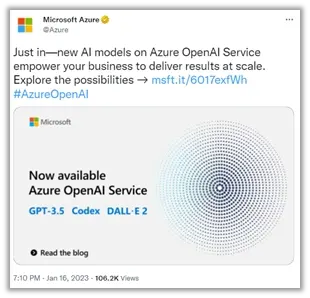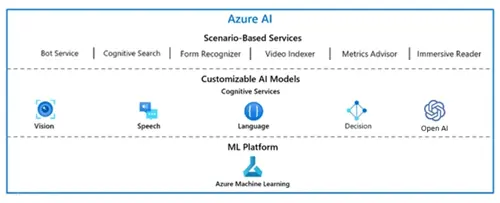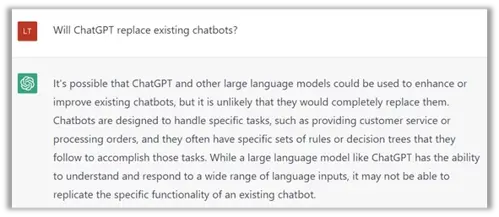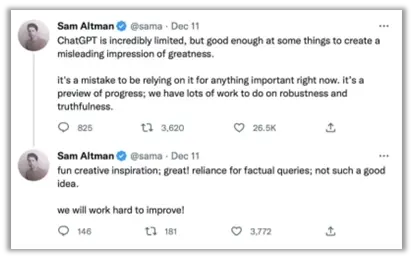In this article, we discuss what the rise of ChatGPT means for those who have a Conversational AI strategy or are thinking of one. There’s never been a better time to talk about talking with machines.
"ChatGPT is the pinnacle of conversational AI, its ability to understand and respond to natural language inputs with such precision and nuance, it blurs the line between human and machine, and has the power to revolutionize the way we interact with technology, making it more intuitive and personalized than ever before”- ChatGPT
On November 30, 2022, OpenAI unveiled ChatGPT- the world's most advanced AI chatbot to date. The tech world can’t stop gushing over it.
The release of ChatGPT was met with widespread acclaim, with many in the tech community expressing their excitement and admiration for its advanced capabilities and impressive performance. With its ability to understand and respond to a wide range of natural language inputs, ChatGPT represents a major leap forward in the field of artificial intelligence and has the potential to revolutionize the way we interact with technology. It has set new benchmarks for Conversational AI. In this article, we discuss what this means for those who have a Conversational AI strategy or are thinking of one. There’s never been a better time to talk about talking with machines.
The “Wow!” that matters
These are some of the ways that ChatGPT is expected to have a significant impact on the field of conversational AI.
Transfer Learning
If you’re not going to benefit as much from deploying an assistant that can answer everything under the sun, there are other ways you will be able to use ChatGPT. One of the key advantages of ChatGPT is that it can be fine-tuned on specific tasks or domains. This process is called transfer learning- a technique where a model that has been trained on one task or dataset is used as a starting point to train a model on a different but related task or dataset. This process allows the model to leverage the knowledge it has learned from the previous task to improve its performance on the new task. Transfer learning can be an efficient way to train a model on a new task, especially when there is limited data available.
By fine-tuning ChatGPT on specific tasks or domains, you can improve the performance of your chatbot by allowing it to leverage the knowledge that ChatGPT has learned from the large corpus of text data it was trained on. This approach can help to reduce the amount of data and computational resources required to train a model from scratch, making it more accessible for developers to use.
Fine-tuning a pre-trained model like ChatGPT allows the model to understand a specific domain- to adapt to a specific task or domain, which can lead to improved performance. For example, if you have a chatbot for customer service and you fine-tune a ChatGPT model with customer service data, the model will have a better understanding of the customer service domain.
Human-like responses
One of the reasons many find it “ridiculously good” is its ability to generate high-quality text or human-like responses in conversational contexts. Imagine having virtual assistants powered by ChatGPT that can have more natural and human-like interactions. This will drastically improve user satisfaction and engagement.
That said, ChatGPT is trained on a large dataset of conversational text. This allows it to understand and respond to a wide range of natural language inputs. When a user interacts with a virtual assistant that is powered by ChatGPT, the model can naturally generate responses that are more human-like, making the conversation feel more natural.
But the real opportunity, as we discussed, is with fine-tuning ChatGPT for specific tasks or domains. This will enable virtual assistants to have a better understanding of the specific domain they are operating in. For example, an assistant for customer service fine-tuned with customer service data, will have a better understanding of the customer service domain and will be able to generate more accurate and helpful responses to customer inquiries.
Contextual relevance
ChatGPT can generate responses that are more contextually relevant, which can lead to more personalized interactions with the virtual assistant. This can lead to improved user satisfaction and engagement and provide more accurate and personalized responses. ChatGPT-powered virtual assistants will have the ability to retain information over the conversation and use it in the next interactions. This will enable them to provide more accurate and helpful responses to user inquiries.
Language capabilities
When ChatGPT arrived on the scene, the digital world relieved a collective sigh as they interacted with a bot that they felt (finally) understood them, even when it really didn’t. ChatGPT is a language model that has been trained on a large corpus of text data, so it has a good understanding of natural language although it has no built-in NLU capabilities. In addition to the fact that it can generate text that is grammatically correct, coherent, and contextually relevant, it can handle multiple intents and understand various nuances of language like sarcasm, irony, humor, etc.
ChatGPT is a powerful language model that has a wide range of language capabilities, including text generation, language understanding, translation, summarization, question answering, language generation, sentiment analysis, and Named Entities Recognition.
Behind the scenes, assisting the agent
ChatGPT can help customer service agents to respond quickly and accurately to customer inquiries, handle multiple intents, reduce response time, handle repetitive tasks, handle different languages, and understand the sentiment of customer's messages.
Build with ChatGPT today
There are several ways to use ChatGPT today to build virtual assistants:
OpenAI API
One of the easiest ways to use the ChatGPT model is through the OpenAI GPT-3 API. OpenAI provides an API that allows developers to access pre-trained models, including ChatGPT, and use them to build applications such as virtual assistants. The API also allows for fine-tuning of the models on specific tasks or domains.
The OpenAI API is not open-sourced, and access to the API is granted by OpenAI through a request process. Developers will need to sign up for an API key and agree to the terms of service in order to use the API. This process includes providing information about their intended use case and agreeing to usage limits.
Once you have an API key, you can use the API to access pre-trained models, including ChatGPT, and use them to build applications, such as virtual assistants. The API also allows for fine-tuning of the models on specific tasks or domains.
Azure Open AI
Microsoft recently announced the general availability of its Azure OpenAI Service. “Customers will also be able to access ChatGPT—a fine-tuned version of GPT-3.5 that has been trained and runs inference on Azure AI infrastructure—through Azure OpenAI Service soon,” said Eric Boyd Corporate Vice President, AI Platform

Azure OpenAI is a platform that allows developers to use pre-trained models from OpenAI, including GPT-3, within Microsoft's Azure cloud platform. Azure OpenAI is built on top of OpenAI’ s GPT-3 model and allows users to perform natural language processing tasks such as text generation, language translation, and question answering. It is designed to be easy to use, so you don't need to be a machine learning expert to use it. It is a part of Azure Cognitive Services which allows developers to leverage pre-built AI models to create applications with intelligent features such as language understanding, sentiment analysis, and more.

According to Microsoft, “Azure OpenAI Service gives customers advanced language AI with OpenAI GPT-3, Codex, and DALL-E models with the security and enterprise promise of Azure. Azure OpenAI co-develops the APIs with OpenAI, ensuring compatibility and a smooth transition from one to the other. With Azure OpenAI, customers get the security capabilities of Microsoft Azure while running the same models as OpenAI. Azure OpenAI offers private networking, regional availability, and responsible AI content filtering.”
The Road Ahead
While models like ChatGPT have the potential to revolutionize the way customer support is handled, it's important to keep in mind that commercial deployments entail much more work. To solve for business outcomes, it needs to be integrated with other key models and AI techniques to ensure that it functions optimally and safely.
ChatGPT is one piece of the puzzle- one that can accelerate the development and elevate the capabilities of your virtual assistant. An assistant is more than just text generation, it also includes natural language understanding and dialogue management, which would require additional components and techniques. As a large language model that has been trained on a large corpus of text data, ChatGPT is able to generate text that is grammatically correct, coherent, and can even be semantically meaningful. However, it doesn't have any built-in capability for natural language understanding (NLU) which is the ability to extract meaning from text. NLU is a complex task that involves understanding the intent of a statement, extracting entities, and identifying relationships between them.

Summary
“We’re going to see advances in 2023 that people two years ago would have expected in 2033. It’s going to be extremely important not just for Microsoft’s future, but for everyone’s future.” ~Brad Smith, Microsoft President
ChatGPT is expected to drive advancements in natural language processing and machine learning and have a significant impact on the field of conversational AI. Fine-tuning ChatGPT on specific tasks or domains can lead to improved performance and enables organizations to create custom models that are tailored to their specific needs.
As of today, there are known limitations to these models and the output is not guaranteed to be factually accurate. Accuracy, Consistency and Explainability are some of the current concerns. Sam Altman, CEO of OpenAI, tweeted, “…it’s a mistake to be relying on it for anything important right now. it’s a preview of progress; we have lots of work to do on robustness and truthfulness.”

At Valorem Reply, ChatGPT has our attention. We are excited to see how the technology will evolve and impact the world of Conversational AI. One of the key contributions that ChatGPT has made is to inspire and motivate professionals in the field to explore new frontiers in conversational AI technology. Thanks to its impressive capabilities, it has the potential to spark new ideas and push the boundaries of what is currently possible in this field.
We understand that while it's important to keep an eye on the rapid advancements in large language models (LLMs), it's crucial for businesses to rely on proven technologies that can be easily trained with relevant business and customer data to create optimal virtual agents and customer experience. And so, while we keep track of the latest developments in LLMs for the time being, we will continue to utilize established technologies, powered by Azure AI, as a reliable approach.
Explore what conversational AI can already do for you today. Get in Touch with our experts.







